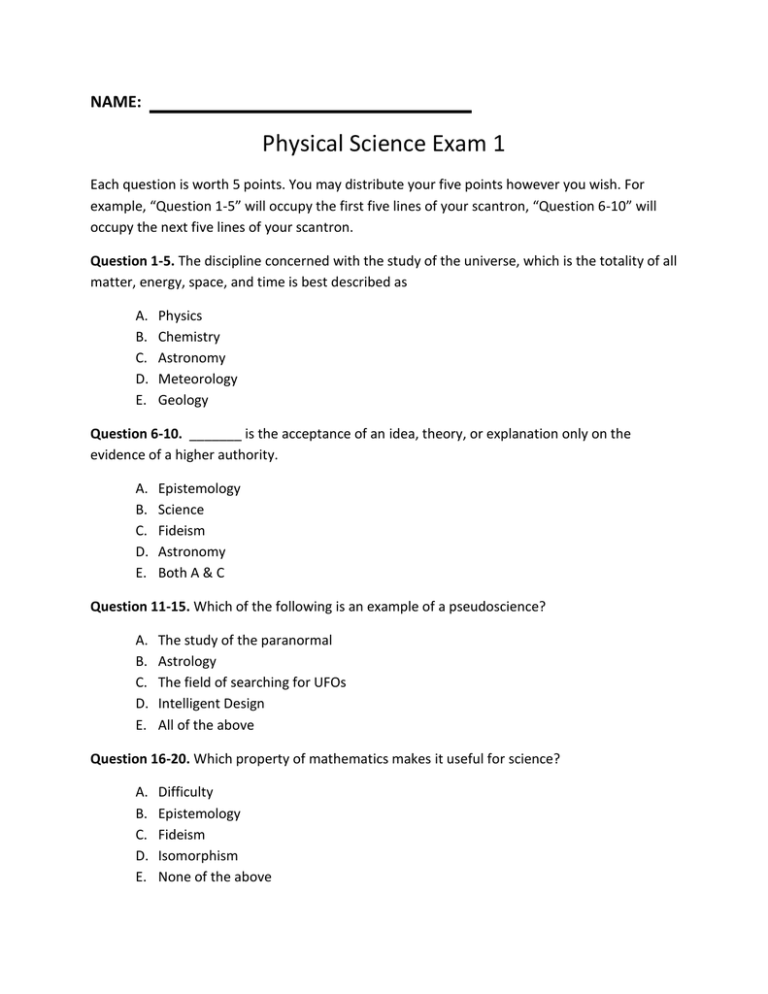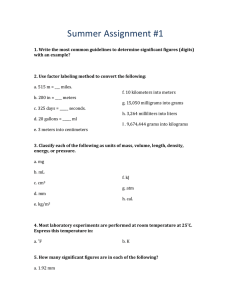Physical Science Exam 1 NAME:
advertisement

NAME: Physical Science Exam 1 Each question is worth 5 points. You may distribute your five points however you wish. For example, “Question 1-5” will occupy the first five lines of your scantron, “Question 6-10” will occupy the next five lines of your scantron. Question 1-5. The discipline concerned with the study of the universe, which is the totality of all matter, energy, space, and time is best described as A. B. C. D. E. Physics Chemistry Astronomy Meteorology Geology Question 6-10. _______ is the acceptance of an idea, theory, or explanation only on the evidence of a higher authority. A. B. C. D. E. Epistemology Science Fideism Astronomy Both A & C Question 11-15. Which of the following is an example of a pseudoscience? A. B. C. D. E. The study of the paranormal Astrology The field of searching for UFOs Intelligent Design All of the above Question 16-20. Which property of mathematics makes it useful for science? A. B. C. D. E. Difficulty Epistemology Fideism Isomorphism None of the above Question 21-25. Who is attributed with the development of Calculus? A. B. C. D. E. Leibniz Galileo Einstein Brahe None of these Question 26-30. The SI standard of time is based on: A. B. C. D. E. the daily rotation of the earth the frequency of light emitted by Kr86 the yearly revolution of the earth about the sun a precision pendulum clock none of these Question 31-35. One kilogram is roughly equal to the weight of a _____. A. B. C. D. E. Pint of milk Baseball Honeybee Red Blood Cell Human Question 36-40. The British base unit for mass is A. B. C. D. E. Kilogram Gram Newton Slug Pound Question 41-45. Which of the following associations is NOT correct? A. B. C. D. E. 100 meters = 1 kilometer 12.4 hectoliters = 1.24 Kiloliters 1.0 grams/cm3 = water density -4 4 x 10 = 0.0004 1 kilometer = 0.62 mile Question 46-50. Give an order-of-magnitude estimate for the height of a human. A. B. C. D. E. 0.1 meters 1 meter 1.8 meters 3.1 meters 10 meters Question 51-55. A car is travelling 35 miles per hour. What is the car’s speed in feet per second? (NOTE: 1 mile = 1760 yards, 1 yard = 3 feet) A. B. C. D. E. 23.8 ft/s 17.1 ft/s 35.0 ft/s 0.019 ft/s 51.3 ft/s Question 56-60. Suppose A = BC, where A has the dimension M/L (mass/length) and C has the dimension L/T (length/time). Then B has the dimension: A. B. C. D. E. T/M L2/TM TM/L2 L2T/M M/L2T Question 61-65. An equation for distance (measured in meters) is: d = at +bt2 where t is time (measured in seconds) and a and b are constants. What must be the units of a and b in order for the equation to be dimensionally correct? A. B. C. D. E. a = m/s ; b = s2/m a = m/s2 ; b = m/s a = m/s ; b =m/s a = m/s ; b = m/s2 a = m/s ; b = s2/m2 Question 66-70. The _________ variable is plotted on the x-axis and the _________ variable is plotted on the y-axis. A. B. C. D. E. controlled ; uncontrolled controlled ; dependent independent ; dependent independent ; uncontrolled dependent ; independent Question 71-75. Which of the following graph represents an inversely proportional relationship. A. B. C. E. None of the above Question 76-80. Which of the following represents the slope of a line? A. B. C. D. E. rise/run (x2 – x1)/(y2 - y1) ∆y/∆x Both A & B Both A & C D. Use the following graph to answer questions 81-100 10 9 Position (Meters) 8 A B 7 6 5 C 4 3 2 D 1 0 0 0.5 1 1.5 2 2.5 3 3.5 4 4.5 5 Time (Seconds) Question 81-85. Referring to the above graph, which particle(s) would represent a “nonlinear” relationship? A. B. C. D. E. A B C D Both B & D Question 86-90. Referring to the above graph, what is the slope of line “C”? A. B. C. D. E. 3.5 m/s 1 m/s 0 m/s -1 m/s 0.29 m/s Question 91-95. Referring to the above graph, which object(s) is traveling with a constant nonzero speed? A. B. C. D. E. A B C B&D A&C Question 96-100. Which particle is traveling with a non-constant speed (e.g. accelerating)? (HINT: Which particle’s slope changes from one second to the next?) A. B. C. D. E. A B C D E NAME: The following data was collected on an unknown substance: Volume (cm3) Mass (Gram) X-Coordinate Y-Coordinate 0.1 1.134 0.2 2 0.3 4 0.4 4.536 0.5 5.7 0.6 6.5 0.7 7.85 0.8 8.95 0.9 8.5 1 10.5 1.1 12.474 1.2 15 1.3 15.5 1.4 16.1 1.5 18.5 1.6 18.144 1.7 19.15 1.8 20.412 1.9 21.75 2 22.68 In the grid provided below graph the data points (5 points): NAME: 2.5 Mass (gr) 2 1.5 1 0.5 0 0 5 10 15 20 Volume (cm3) On the graph draw the best fit line? (2 points) In the space below calculate the slope of the best fit line, make sure to show all your work. (5 points) 25 What quantity does this slope represent? (2 points) Given the following table, which material do you believe this sample represents? (2 points) Material Gold Platinum Bronze Lead Aluminum Density 19.3 g/cm3 21.4 g/cm3 8.96 g/ cm3 11.34 g/cm3 2.70 g/ cm3




